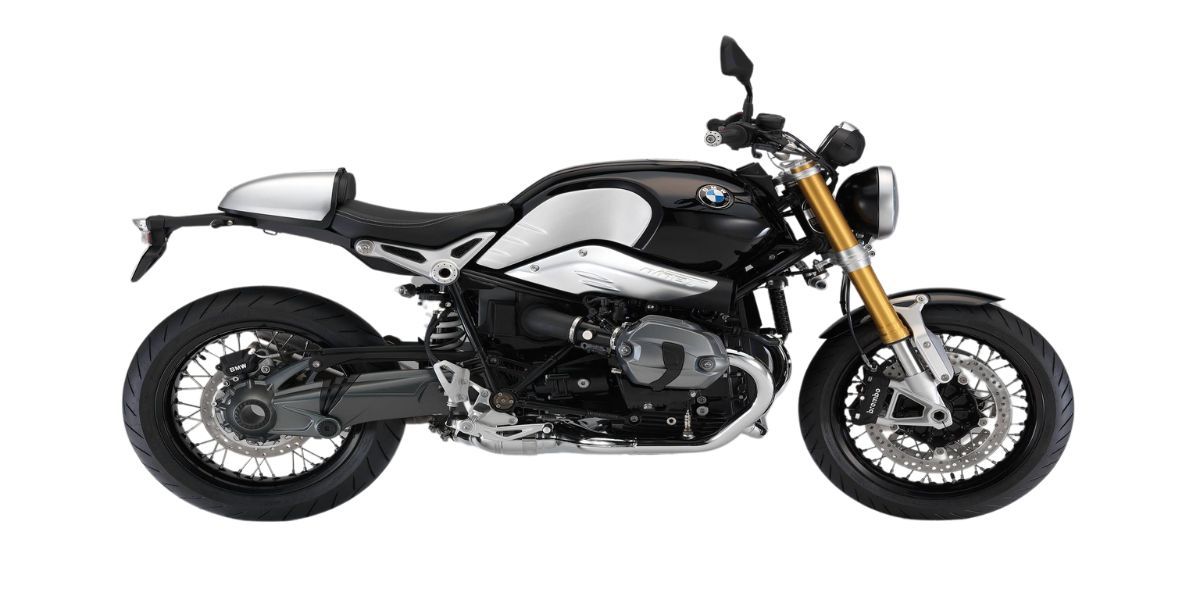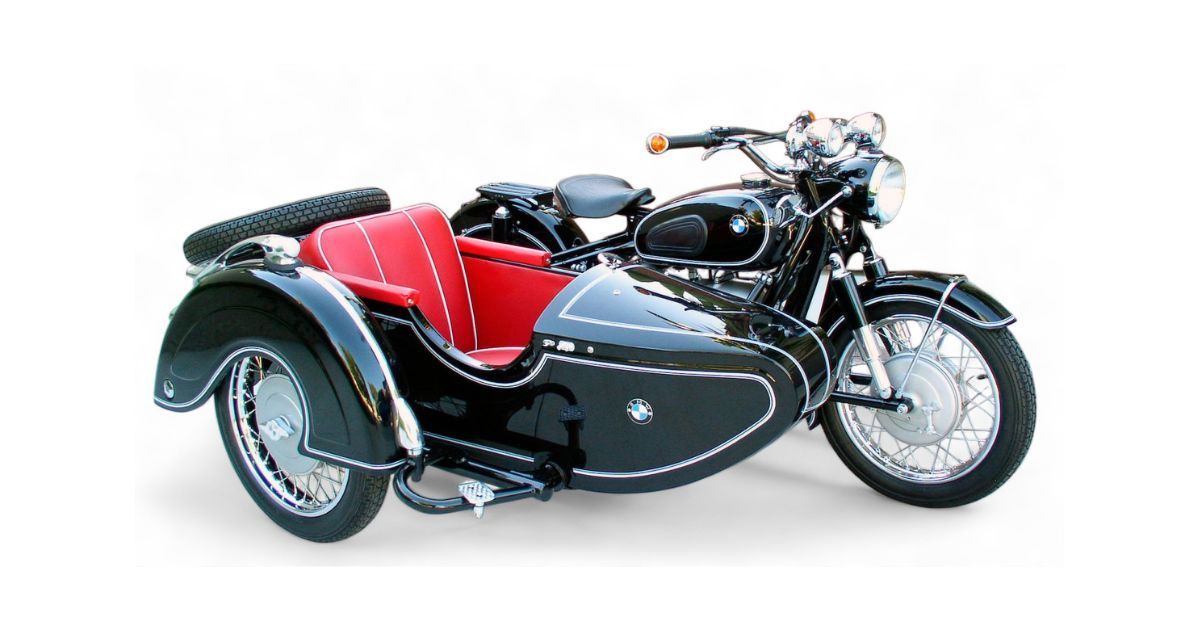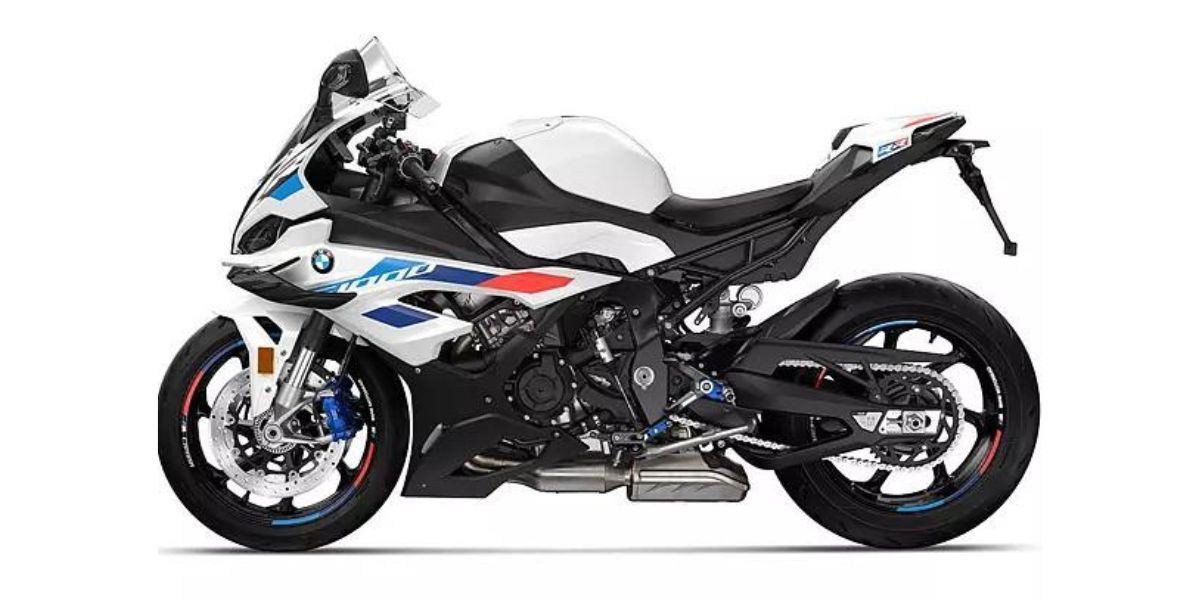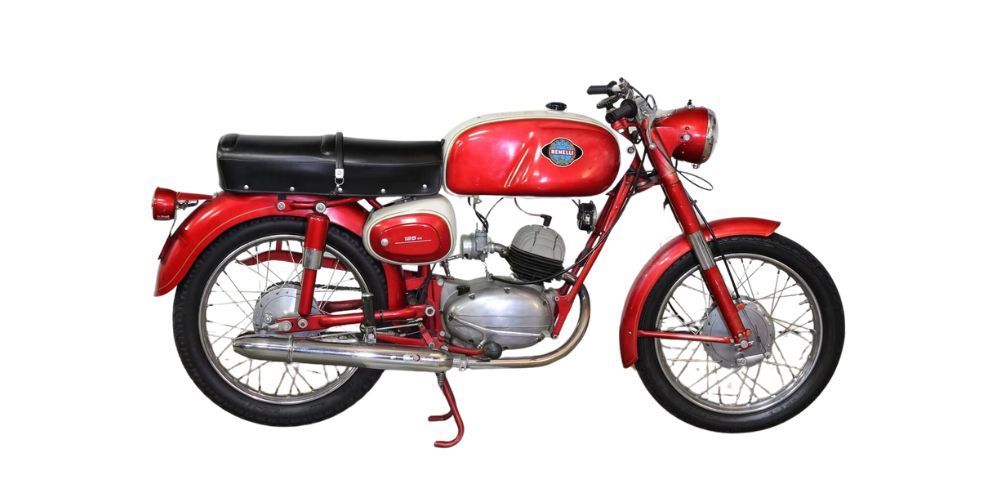1975 BMW R60/6
The 1975 BMW R60/6 marks a special place in motorcycle history. It's part of BMW's "slash six" models that brought modern changes to the classic bike appeal, setting the bar high for motorcycles manufactured during this era. But there's an unexpected twist to this tale. Yes, these bikes came with more power due to increased displacement and improved braking with disk brakes' introduction, yet they managed to retain their charm with classic designs like a slim US-market tank and wider handlebars. Timeless craftsmanship at its best, wouldn't you say?
The 1975 BMW R60/6 motorcycle is known for its air-cooled opposed-twin (boxer) engine, telescopic front forks, and a slim US-market tank. Its top speed reaches 103mph, and it has a curb weight of 462lb. Additionally, this vintage bike exudes classic elegance and is highly regarded for its distinctive engine sound.
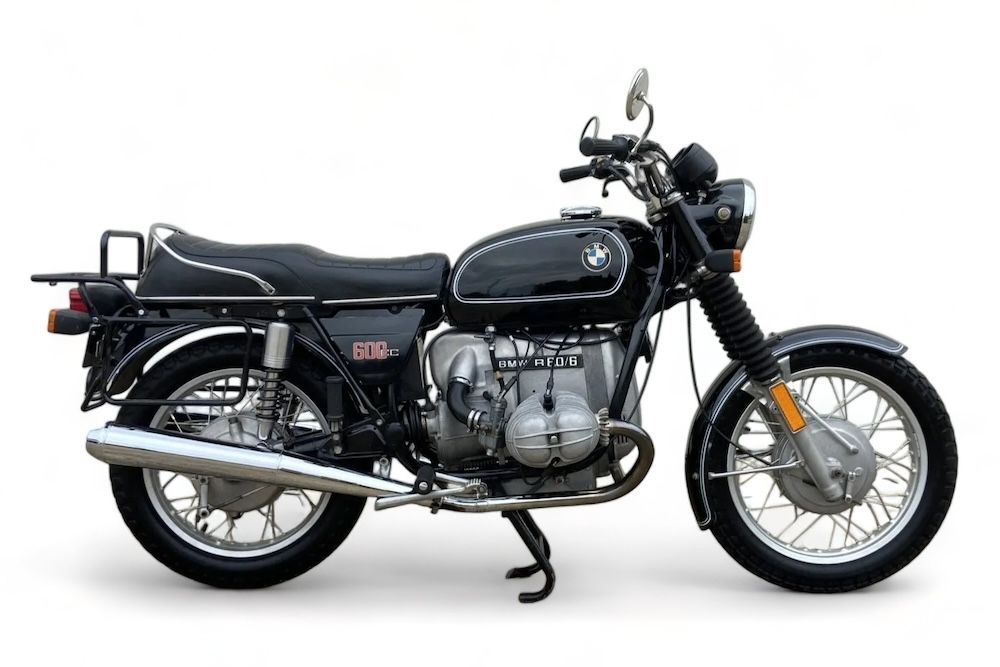
The History of the 1975 BMW R60/6
In 1975, the release of the R60/6 marked a significant transition in BMW's motorcycle design philosophy. This mid-range model bridged the gap between the smaller R50/5 and the larger R75/6, creating a balanced and versatile offering for motorcycle enthusiasts. The "slash six" series was a demonstration of BMW's commitment to innovation and progression, as it introduced a host of modern features while still preserving the timeless appeal of BMW's boxer twin motorcycles.
The incorporation of angular changes like the displacement increase, introduction of disc brakes (front only), and relocation of the gauge pod signaled a departure from traditional configurations, embracing advancements that reflected evolving consumer demands and technological capabilities. These modifications enhanced performance, control, and overall riding experience for enthusiasts, securing a strong foothold in the competitive motorcycle market.
Furthermore, the shift towards more modern features did not compromise the inherent characteristics that defined BMW motorcycles. The air-cooled, four-stroke, opposed-twin (boxer) engines with hemispherical combustion chambers remained a signature trait, emphasizing BMW's unwavering dedication to blending tradition with innovation.
It's essential to recognize that this era represented an intersection between heritage and advancement, embodying BMW's ethos of excellence and adaptability. The 1975 BMW R60/6 epitomized the brand's ability to evolve without forsaking its roots, capturing the hearts of riders seeking classic allure intertwined with contemporary performance.
Immersed in the historical context of the 1975 BMW R60/6, it becomes evident that this model holds a special place in BMW's illustrious lineage, symbolizing a harmonious fusion of tradition and progress continuing to resonate with motorcycle aficionados worldwide.
Classic Features of the 1975 Model
The 1975 BMW R60/6 is a true gem of motorcycle design, boasting a striking vintage aesthetic that captures the essence of an era. One of its most iconic features is the slim US-market tank, which exudes understated elegance and harks back to a time when motorcycles were celebrated for their simplicity and timeless appeal. The tank not only defines the bike's aesthetic but also symbolizes an era defined by craftsmanship and attention to detail.
Moreover, the wider handlebars of the R60/6 contribute to its classic charm, evoking a sense of freedom and control synonymous with vintage riding experiences. These broader handlebars aren't just about aesthetics; they offer enhanced maneuverability and stability, providing riders with a sense of command over their machine. With roots deep in classic motorcycle design philosophy, these wider bars perfectly complement the overall styling of the R60/6, capturing the spirit of adventure and exploration that defines vintage riding.
When it comes to performance, the original shocks with levers for adjusting spring pre-load on the R60/6 are a testament to thoughtful engineering and attention to rider comfort. These distinctive shocks not only enhance the motorcycle's visual appeal but also offer precise control over suspension settings, allowing riders to tailor their riding experience to suit their preferences.
In addition, while some may overlook it in favor of modern braking systems, the front drum brake on the R60/6 retains effectiveness when well-maintained. Surprisingly efficient when properly cared for, this classic braking system seamlessly combines functionality with nostalgia, reminding riders of an era when reliability was achieved through elegant simplicity.
The classic features of the 1975 BMW R60/6 not only contribute to its timeless aesthetic appeal but also reflect a commitment to craftsmanship, functionality, and rider experience that continues to captivate enthusiasts today.
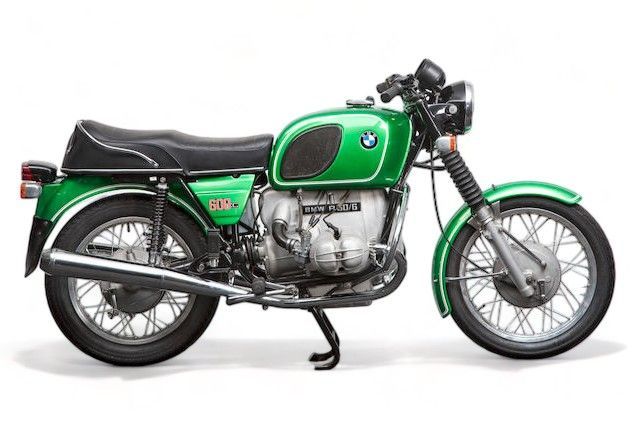
Detailed Specifications of BMW R60/6
The heart of the BMW R60/6 is its opposed-twin (boxer) engine, a hallmark of BMW motorcycles. This 599cc powerhouse generates 40hp at 6,400rpm and boasts an impressive 36 ft⋅lbf of torque at 5,000rpm. The alternator, meticulously crafted by Bosch, provides 12V and 280 Watts to ensure the bike remains powered. This engine stands as a prime example of German engineering excellence, renowned for its reliability and durability.
What these numbers really signify is the robust performance this vintage motorcycle delivers. As you push past the twists and turns of the road, each rev of this boxer engine propels you forward with a steady 40 horsepower at your disposal. Furthermore, the torque of 36 ft⋅lbf allows for smooth acceleration and sustained speed as you navigate your way through various riding conditions.
Consider this scenario: You're cruising down a scenic highway, feeling the wind rush by as you embrace the open road. Every twist of the throttle gives you access to that 40 horsepower, making every ride an exhilarating experience that connects you to the true essence of motorcycling.
Additionally, the top speed of the R60/6 reaches approximately 103mph, placing it firmly within the realm of respectable road performance. Despite its power, it maintains a manageable curb weight of 462lb, ensuring a harmonious blend of agility and stability.
The presence of an alternator from Bosch significantly contributes to the entire system's efficiency. Operating at 12V and 280 Watts, it plays a vital role in powering the bike's electrical components, further reinforcing its reliability and longevity.
By examining these detailed specifications, we gain a better understanding of the impressive capabilities and design intricacies that make the BMW R60/6 an enduring classic.
Analysing Performance and Build Quality
The BMW R60/6 pioneers a riding experience synonymous with reliability, smoothness, and distinctive character. Equipped with a boxer twin engine, this motorcycle offers inherent balance and stability adored by enthusiasts. The configuration of the boxer engine not only contributes to the motorcycle's smooth power delivery but also generates a unique and sonorous exhaust note—much sought after by riders who appreciate the intricate symphony created by their machine. It's akin to music that resonates with every twist of the throttle, making each journey memorable and enjoyable.
Diving into its build quality, the R60/6 emerges as a paragon of durability and sturdiness. Crafted with exceptional attention to detail, this vintage marvel exudes an air of dependability that instills confidence in its rider. Every material selection, from the robust frame to the resilient components, speaks volumes about BMW's commitment to creating a motorcycle that can withstand daily commuting and long-haul touring demands. The solid feel of the motorcycle gives riders an assurance of its trustworthiness, establishing it as a true companion for any road expedition.
BMW's dedication to precision engineering is palpable in every facet of the R60/6's design. From the meticulously crafted engine components to the steadfast frame, every element aligns cohesively to cultivate a burgeoning reputation as a reliable workhorse for riders seeking both practicality and an indelible connection with their machine.
Owning a BMW R60/6 is akin to having a steadfast companion on your adventures. Just like a trusted friend who stands beside you through thick and thin, this motorcycle embodies longevity and assurance, making every ride an exploration filled with unwavering confidence.
As we continue our journey through the legacy of the BMW R60/6, we're unravelling a story steeped in dependability and unmatched craftsmanship. This vintage motorcycle not only stands the test of time but also shines as a testament to BMW's unyielding dedication to crafting enduring machines that leave an indelible mark on both riders and enthusiasts alike.
Now, as we transition forward into examining the precise engineering and performance aspects of this iconic motorcycle, let's delve into scrutinizing suspension and brakes.
- The 1975 BMW R60/6 is powered by a 599 cc engine, delivering 40 horsepower.
- Approximately 3,500 units of the 1975 BMW R60/6 were produced.
- With a top speed of 100 mph, the R60/6 can accelerate from 0 to 60 mph in just 7 seconds.
- The fuel efficiency of the R60/6 is an impressive 55 miles per gallon.
- The average price for a well-maintained and original condition 1975 BMW R60/6 today ranges between $8,000 and $12,000.
Scrutinizing Suspension and Brakes
The 1975 BMW R60/6 is equipped with a suspension system that has garnered admiration for its balanced ride and excellent handling, thanks to the inclusion of telescopic front forks and a rear swing arm suspension. These features provide riders with a comfortable and secure riding experience, enabling smooth navigation through various terrains and conditions.
The telescopic front forks contribute to the motorcycle's stability and control, absorbing shocks from bumps and imperfections on the road. They effectively enhance the bike's responsiveness, making it easier for riders to maneuver through tight corners or uneven surfaces. The rear swing arm suspension complements this by maintaining the overall balance of the motorcycle, ensuring a stable and controlled ride.
Front Brake Performance
The presence of the front drum brake is significant in the R60/6, delivering reliable stopping power when properly set up. While disc brakes have become more common in modern motorcycles, the front drum brake on the R60/6 remains effective due to its engineering and functionality. When maintained and adjusted correctly, this braking system ensures responsive and controlled stopping, contributing to the overall safety of the motorcycle.
Now, let's delve into the technological elements behind this gravity-defying performance. The front suspension consists of telescopic fork with hydraulic shock absorbers that absorb impacts, providing a smooth ride even on rugged terrain. On the other hand, the rear suspension features a long swinging arm with adjustable hydraulic shock absorbers that minimize bouncing and stabilize the motorcycle during acceleration or braking.
It's important to recognize that while drum brakes may not be as common in today's motorcycles, they still hold merit when well-maintained and calibrated. In fact, they possess their own advantageous features when it comes to simplicity, durability, and ease of adjustment. A properly set up front drum brake on the R60/6 allows for precise modulation of braking force and can inspire confidence in riders when navigating different road conditions.
By carefully considering both the suspension system and braking capabilities of the 1975 BMW R60/6, we gain a deeper understanding of its engineering excellence. These crucial components contribute significantly to its overall performance and safety, ensuring a satisfying riding experience for enthusiasts and collectors alike.
In examining these intricate details of the 1975 BMW R60/6, we uncover the significant engineering prowess embedded within this vintage masterpiece.
Inside the Electrical System
When it comes to vintage motorcycles, understanding the electrical system can seem daunting. However, the electrical setup of the R60/6 is surprisingly elegant and efficient. The 12-volt alternator provides a steady charge to keep the electrics running smoothly, while both the standard tachometer and the turn signals ensure you have all the essential information at a glance.
The 12-volt alternator is a critical component, generating electricity to power all the electronics on the motorcycle, ensuring reliable and consistent operation of lights, ignition systems, and other electrical components. It's like the powerhouse behind the scenes, quietly providing necessary energy for trouble-free operation. Additionally, the inclusion of standard turn signals facilitates clear and effective communication of your intentions to other road users, contributing to safer riding conditions, especially in traffic and when making turns. The presence of a tachometer further emphasizes providing essential information to the rider at all times.
Imagine cruising down a winding road as dusk settles in, your trusty R60/6 humming beneath you. The 12-volt alternator silently keeps everything powered up, ensuring that your headlight shines bright and your turn signals remain visible in the gathering gloom. Meanwhile, the tachometer gives you real-time feedback, assisting in subtle adjustments as you navigate each twist and turn with precision.
This reliable electrical setup underscores BMW's core philosophy: providing a dependable, user-friendly experience. It symbolizes the practical yet innovative approach that has made BMW motorcycles a staple among enthusiasts for decades.
Owning a vintage motorcycle like the R60/6 isn't just about reveling in nostalgia; it's about experiencing firsthand the thoughtful engineering that defined an era of motorcycling innovation. Continuing to explore this exceptional machine unveils why it holds such timeless appeal.
As we immerse ourselves further into this vintage masterpiece's details, let's encounter firsthand what it feels like to ride this iconic machine.
Experience of Riding the Vintage Motorcycle
Owning a vintage motorcycle like the 1975 BMW R60/6 is akin to holding a piece of history in your hands. A ride on this classic machine isn't just about getting from point A to point B; it's an immersive journey that engages all the senses.
The first thing you notice is the distinctive engine noise as the bike rumbles to life. Unlike modern motorcycles, the signature sound of the R60/6 at idle has been likened to "putting Barry White in a simmering volcano." It's a deep, rhythmic thrum that is one of the defining characteristics of this vintage model. This unique auditory experience is something that modern bikes simply cannot replicate, adding an emotional and nostalgic layer to the ride.
As you hit the road, the handling and responsiveness of the R60/6 bring a sense of connection and authenticity that newer bikes often struggle to match. The mechanical feedback through the handlebars, combined with the smooth but robust power delivery from the boxer twin engine, creates a dynamic and engaging riding experience. It's as if every twist of the throttle and shift of gear is a direct conversation between rider and machine.
Enthusiasts and owners cherish these older motorcycles not just for their performance, but for the unmistakable charm they exude. It's akin to owning a classic car or collecting fine art—there's an irreplaceable elegance and sophistication that comes with riding a vintage machine. The timeless design, paired with the idiosyncrasies that are unique to older models, cultivates an undeniable aura that is far removed from today's high-tech, mass-produced motorcycles.
In a world progressively dominated by advanced technology and sleek, futuristic designs, there's something profoundly appealing about stepping into the past with a vintage motorcycle like the 1975 BMW R60/6. It offers an experience that transcends mere transportation, tapping into a sense of nostalgia and tradition that continues to captivate riders across generations.
Riding a vintage motorcycle is not just about moving from one place to another; it's about immersing yourself in history, reveling in its distinct charm and creating lasting connections with both man and machine.
- The 1975 BMW R60/6 is a vintage motorcycle produced by BMW Motorrad.
- It features a 600cc air-cooled, opposed-twin engine.
- The R60/6 has a top speed of around 110 mph (177 km/h).
- It is known for its classic design and durable build quality.
- The motorcycle was manufactured between 1973 and 1976, offering riders a comfortable and reliable touring experience.
Who designed the 1975 BMW R60/6?
The 1975 BMW R60/6 was designed by Hans-Günther von der Marwitz, a German designer who worked for BMW Motorrad. Von der Marwitz played a significant role in shaping the design of BMW motorcycles during that era, including the R60/6. He was known for his contributions to the motorcycle industry and his innovative designs that combined both style and functionality.
How fast can a 1975 BMW R60/6 go?
The 1975 BMW R60/6, a classic motorcycle renowned for its performance and reliability, has a top speed of approximately 103 miles per hour (166 kilometers per hour). This impressive speed is achieved thanks to its robust 599cc air-cooled boxer twin engine, which generates an impressive 40 horsepower. The R60/6's aerodynamic design and lightweight frame also contribute to its exceptional speed capabilities. Whether cruising on the open road or navigating through city streets, this iconic BMW motorcycle offers an exhilarating riding experience that is sure to leave enthusiasts in awe.
What are the common issues with the 1975 BMW R60/6?
Common issues include wear and tear on the electrical system, potential oil leaks, and carburetor problems due to age or poor maintenance. Regular checks and maintenance can mitigate most of these issues.
About the Author
William Flaiz, passionate about European motorcycle brands, shares his expertise and stories on RunMotorun.com. He offers detailed insights and reviews, aiming to educate both seasoned enthusiasts and newcomers. Flaiz combines personal experience with thorough research, welcoming visitors to explore the rich world of European motorcycles alongside him.


